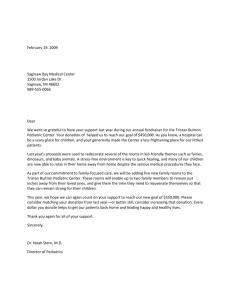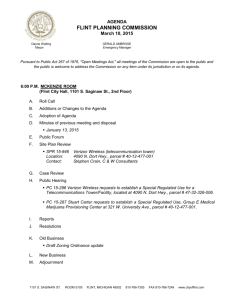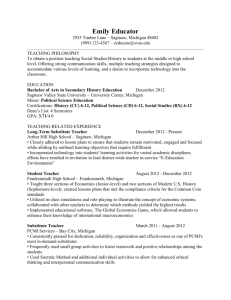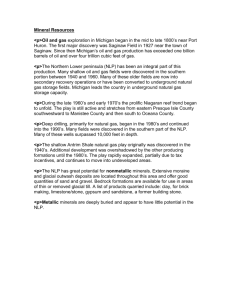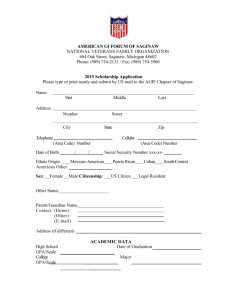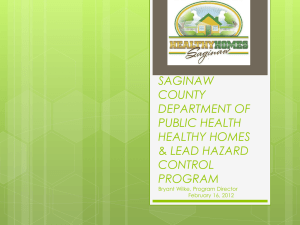PO BOX 5081 - City of Saginaw MI
advertisement
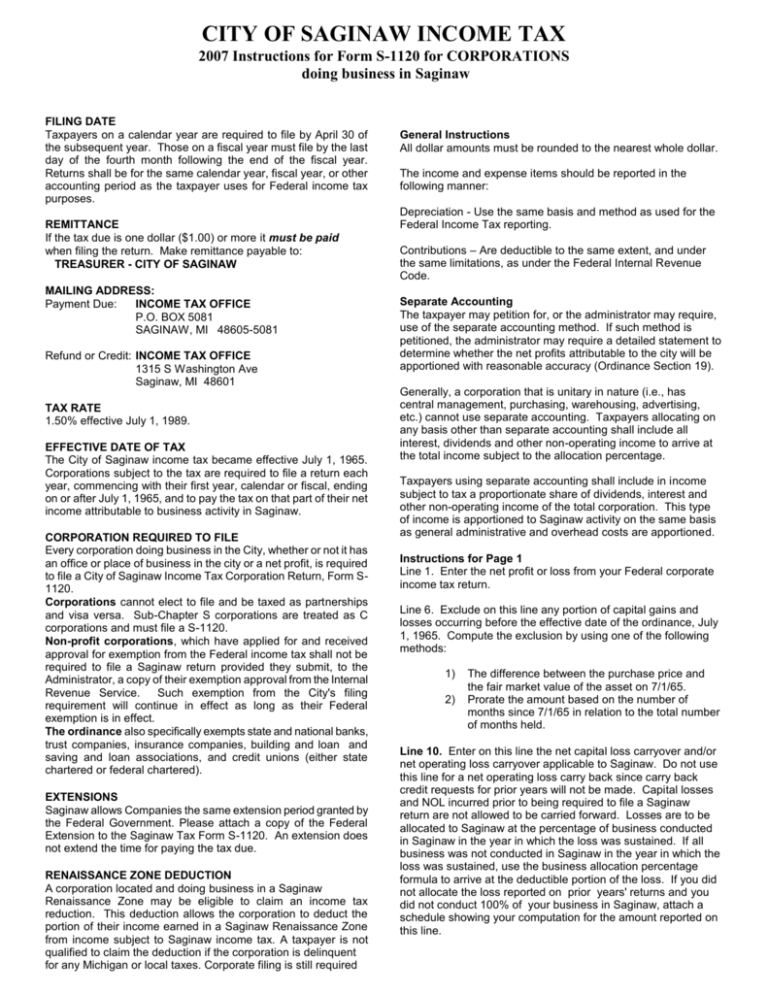
CITY OF SAGINAW INCOME TAX 2007 Instructions for Form S-1120 for CORPORATIONS doing business in Saginaw FILING DATE Taxpayers on a calendar year are required to file by April 30 of the subsequent year. Those on a fiscal year must file by the last day of the fourth month following the end of the fiscal year. Returns shall be for the same calendar year, fiscal year, or other accounting period as the taxpayer uses for Federal income tax purposes. REMITTANCE If the tax due is one dollar ($1.00) or more it must be paid when filing the return. Make remittance payable to: TREASURER - CITY OF SAGINAW MAILING ADDRESS: Payment Due: INCOME TAX OFFICE P.O. BOX 5081 SAGINAW, MI 48605-5081 Refund or Credit: INCOME TAX OFFICE 1315 S Washington Ave Saginaw, MI 48601 TAX RATE 1.50% effective July 1, 1989. EFFECTIVE DATE OF TAX The City of Saginaw income tax became effective July 1, 1965. Corporations subject to the tax are required to file a return each year, commencing with their first year, calendar or fiscal, ending on or after July 1, 1965, and to pay the tax on that part of their net income attributable to business activity in Saginaw. CORPORATION REQUIRED TO FILE Every corporation doing business in the City, whether or not it has an office or place of business in the city or a net profit, is required to file a City of Saginaw Income Tax Corporation Return, Form S1120. Corporations cannot elect to file and be taxed as partnerships and visa versa. Sub-Chapter S corporations are treated as C corporations and must file a S-1120. Non-profit corporations, which have applied for and received approval for exemption from the Federal income tax shall not be required to file a Saginaw return provided they submit, to the Administrator, a copy of their exemption approval from the Internal Revenue Service. Such exemption from the City's filing requirement will continue in effect as long as their Federal exemption is in effect. The ordinance also specifically exempts state and national banks, trust companies, insurance companies, building and loan and saving and loan associations, and credit unions (either state chartered or federal chartered). EXTENSIONS Saginaw allows Companies the same extension period granted by the Federal Government. Please attach a copy of the Federal Extension to the Saginaw Tax Form S-1120. An extension does not extend the time for paying the tax due. RENAISSANCE ZONE DEDUCTION A corporation located and doing business in a Saginaw Renaissance Zone may be eligible to claim an income tax reduction. This deduction allows the corporation to deduct the portion of their income earned in a Saginaw Renaissance Zone from income subject to Saginaw income tax. A taxpayer is not qualified to claim the deduction if the corporation is delinquent for any Michigan or local taxes. Corporate filing is still required General Instructions All dollar amounts must be rounded to the nearest whole dollar. The income and expense items should be reported in the following manner: Depreciation - Use the same basis and method as used for the Federal Income Tax reporting. Contributions – Are deductible to the same extent, and under the same limitations, as under the Federal Internal Revenue Code. Separate Accounting The taxpayer may petition for, or the administrator may require, use of the separate accounting method. If such method is petitioned, the administrator may require a detailed statement to determine whether the net profits attributable to the city will be apportioned with reasonable accuracy (Ordinance Section 19). Generally, a corporation that is unitary in nature (i.e., has central management, purchasing, warehousing, advertising, etc.) cannot use separate accounting. Taxpayers allocating on any basis other than separate accounting shall include all interest, dividends and other non-operating income to arrive at the total income subject to the allocation percentage. Taxpayers using separate accounting shall include in income subject to tax a proportionate share of dividends, interest and other non-operating income of the total corporation. This type of income is apportioned to Saginaw activity on the same basis as general administrative and overhead costs are apportioned. Instructions for Page 1 Line 1. Enter the net profit or loss from your Federal corporate income tax return. Line 6. Exclude on this line any portion of capital gains and losses occurring before the effective date of the ordinance, July 1, 1965. Compute the exclusion by using one of the following methods: 1) 2) The difference between the purchase price and the fair market value of the asset on 7/1/65. Prorate the amount based on the number of months since 7/1/65 in relation to the total number of months held. Line 10. Enter on this line the net capital loss carryover and/or net operating loss carryover applicable to Saginaw. Do not use this line for a net operating loss carry back since carry back credit requests for prior years will not be made. Capital losses and NOL incurred prior to being required to file a Saginaw return are not allowed to be carried forward. Losses are to be allocated to Saginaw at the percentage of business conducted in Saginaw in the year in which the loss was sustained. If all business was not conducted in Saginaw in the year in which the loss was sustained, use the business allocation percentage formula to arrive at the deductible portion of the loss. If you did not allocate the loss reported on prior years' returns and you did not conduct 100% of your business in Saginaw, attach a schedule showing your computation for the amount reported on this line. 2007 Instructions for Form S-1120 for CORPORATIONS doing business in Saginaw Continued SCHEDULE D The business allocation percentage formula is to be used by corporations with business activity both within and outside the City of Saginaw unless permission has been granted to use the separate accounting method. Line 1. Enter in Column 1 the average net book value of all real and tangible personal property including inventories owned by the business, regardless of location; and in Column 2 show the net book value of the real and tangible personal property including inventories located in the City of Saginaw. The average net book value of real and tangible personal property including inventories may be determined by adding the net book values at the beginning of the year and the net book values at the end of the year and dividing the sum thus obtained by two. Any other method, which will accurately reflect the average net book value for the year, will also be permitted. Line 1a. Enter in Column 1 the gross annual rentals multiplied by 8 for all rented property regardless of location. In Column 2 show the gross annual rentals multiplied by 8 for all rented property located in the City of Saginaw. Gross annual rentals refer to real property only rented or leased during the taxable period, and should include the actual sums of money or other consideration payable, directly or indirectly, by the taxpayer for the use of possession of such property. Line 2. Enter in Column 1 the total compensation paid to all employees during the year and in Column 2 show the amount of compensation paid to employees for work or services performed within the City of Saginaw during the year. Line 3. Enter in Column 1 the total gross revenue from all sales or services rendered during the year and in Column 2 show the amount of revenue derived from sales made or services rendered in the City of Saginaw during the year. SCHEDULE E Line 1. Use this line to adjust net profit for those items reflected in the taxable period, which are attributable to any period prior to being subject to the Saginaw Income Tax. Line 2. Line 5. The Saginaw City Income Tax Ordinance provides for the specific exclusion from the tax of interest from obligations of the United States, the states or subordinate units of government of the state. Line 6. If you reported dividend income, enter on this line the amount of the dividend received deductions allowed by the Federal Internal Revenue Code for dividends received. Line 7. Taxpayers may deduct income, war profits and excess profits taxes imposed by foreign countries or possessions of the United States, allocable to income included in taxable net income, any part of which would be allowable as a deduction in determining federal taxable income under the applicable provisions of the Federal Internal Revenue Code. Line 8. You may subtract any job credit taken on the Federal return. SCHEDULE G LINE 1. Net operating losses carried forward are to be reported on this line. There is no provision for carrying back losses to prior tax years. Carryover losses are to be allocated to Saginaw at the percentage of business conducted in Saginaw in the year in which the loss was sustained. If all business was not conducted in Saginaw in the year in which the loss was sustained, use the business allocation percentage formula to arrive at the deductible portion of the loss. Attach a schedule showing your computation for the amount reported on this line. LINE 2. Enter on this line the net capital loss carryover applicable to Saginaw. Net capital losses sustained by a corporation for periods subsequent to July 1, 1965, may be carried forward in the same manner as under the federal Internal Revenue Code. No deduction will be allowed for capital losses sustained prior to July 1, 1965. If all business was not conducted in Saginaw in the year in which the loss was sustained, use the business allocation percentage formula to arrive at the deductible portion of the loss. Attach a schedule showing your computation for the amount reported on this line. LINE 3. Corporations who are partners in a business activity taxed as a partnership that has business activity in Saginaw must enter on this line their portion of the Saginaw taxable income or loss from the partnership(s). Attach a schedule showing your computation for the amount reported on this line including the name and taxpayer identification number of the partnership(s). COMPUTATION AND PAYMENT OF TAX After computing your Saginaw Income Tax and deducting your credits, if there is any tax due it must be paid when filing this return. DECLARATION AND PAYMENT OF ESTIMATED TAX Corporations must make estimated tax payments every year that their total City tax will exceed $250.00. To make estimated payments, file a Saginaw Declaration of Estimated Tax . Estimated taxes are payable in four equal installments. The payments are due on the last day of the 4 th, 6th, 9th and 13th month after the start of your fiscal year. For calendar year taxpayers, the payments are due on April 30, June 30, September 30, and January 31. You may also pay in full with the first voucher. ASSISTANCE If you have questions, would like to request forms, or need assistance in preparing your return call (989) 759-1651. Questions by mail should be directed to: Saginaw Income Tax Department, 1315 S. Washington Ave, Saginaw, Michigan 48601. WEBSITE Income tax forms, instructions and additional information are available under the Income Tax Department section of the City of Saginaw website, www.Saginaw-MI.com NOTICE SCHEDULE F S corporations must file as C corporations. Schedule F is used to reconcile the amount reported on line 1, page 1 S-1120 with Federal Form 1120S and Schedule K. These instructions are interpretations of the Saginaw Income Tax Ordinance. The Ordinance will prevail in any disagreement between the instructions and the Ordinance.

